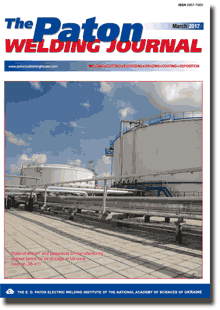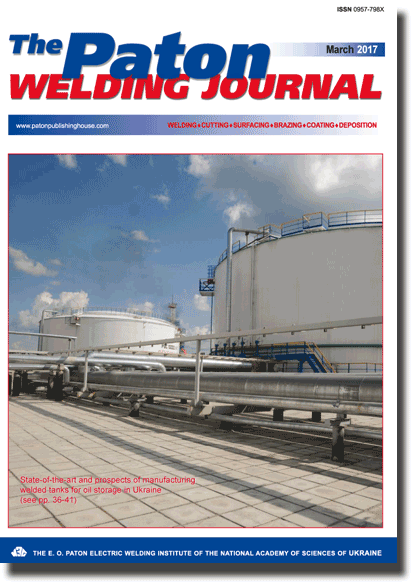| 2017 №03 (06) |
DOI of Article 10.15407/tpwj2017.03.07 |
2017 №03 (08) |

The Paton Welding Journal, 2017, #3, 42-48 pages
State-of-the-art of methods for improvement of corrosion resistance and corrosion fatigue resistance of welded joints (Review)
S.A. Solovej
E.O. Paton Electric Welding Institute, NASU 11 Kazimir Malevich Str., 03680, Kiev, Ukraine. E-mail: office@paton.kiev.ua
Abstract
To improve the service reliability of products and welded structures in the conditions of corrosive environment, the methods of surface plastic deformation of metal are applied, which impart the physical-mechanical properties to the hardened layer, differed from the base metal. The technical progress contributes not only to the development of new methods of surface plastic deformation (for example, surface fusion using a nanopulsed laser), but also to the continuous improvement of conventional methods (shot blasting, pressure treatment, etc.), the efficiency of which was proved in practice. The aim of this review is to evaluate the current state of use of surface plastic deformation methods to increase the corrosion fatigue resistance and durability of steels and welded joints. The analysis of literature data showed that the experimental investigations of recent years are mainly devoted to the determination of efficiency of hardening the stainless steels and their joints applying these methods for subsequent application in such areas as medicine (implants), nuclear power engineering (reactors) and shipbuilding. For the treatment of welded metal structures, the most promising is ultrasonic impact treatment due to compactness and mobility of the equipment, ecological compatibility of the technological process, high efficiency, capability of strengthening the welded joints in any spatial positions in the field conditions. 37 Ref., 4 Figures.
Keywords: welded joint, corrosion, surface plastic deformation, ultrasonic impact treatment, corrosion fatigue, corrosion resistance
Received: 01.02.17
Published: 19.04.17
References
- Chaevsky, M.I., Shatinsky, V.F. (1970) Increase of serviceability of steels in aggressive media under cyclic loading. Kiev: Naukova Dumka.
- Pokhmursky, V.I. (1974) Corrosion-fatigue strength of steels and methods of its improvement. Kiev: Ibid.
- (1982) Corrosion fatigue of metals. In: of 1st Soviet-Engl. Seminar. Ed. by Ya.M. Korotyrkin. Kiev: Ibid.
- Pokhmursky, V.I., Khoma, M.S. (2008) Corrosion fatigue of metals and alloys. Lviv: SPOLOM.
- Chausov, M. et al. (2016) Enhancing plasticity of high-strength titanium alloys VT22 under impact-oscillatory loading. Philosophical Magazine, Vol. 97, 389–399. https://doi.org/10.1080/14786435.2016.1262973
- Aymen, A. Ahmed et al. (2014) Effect of surface and bulk plastic deformations on the corrosion resistance and corrosion fatigue performance of AISI316L. Surface & Coating Technology, Vol. 259, 448–455. https://doi.org/10.1016/j.surfcoat.2014.10.052
- Hashemi, B., Rezaee, M., Yazdi, Azar V. (2011) The wear and corrosion resistance of shot peened-nitrided 316L austenitic stainless steel. Materials & Design, 32, 3287–3292. https://doi.org/10.1016/j.matdes.2011.02.037
- Aymen, A. Ahmed et al. (2015) Effect of shot peening parameters and hydroxyapatite coating on surface properties and corrosion behavior of medical grade AISI316L stainless steel. Surface & Coating Technology, Vol. 280, 347–358. https://doi.org/10.1016/j.surfcoat.2015.09.026
- Hang-sang Lee et al. (2009) Influence of peening on the corrosion properties of AISI304 stainless steel. Corrosion Sci., Vol. 51, 2826–2830.
- Mordyuk, B.N. et al. (2007) Effect of structure evolution induced by ultrasonic peening on the corrosion behavior of AISI321 stainless steel. Sci. and Engineering A, Vol. 458, 253–261. https://doi.org/10.1016/j.msea.2006.12.049
- Dong, Z. et al. (2015) Effect of ultrasonic impact peening on the corrosion of ferritic-martensitic steels in supercritical water. of Nuclear Materials, 457, 266–272. https://doi.org/10.1016/j.jnucmat.2014.11.028
- Balusamy, T. et al. (2013) Influence of surface mechanical attrition treatment (SMAT) on the corrosion behavior of AISI304 stainless steel. Corrosion Sci., Vol. 74, 332–344.
- Pereda, M.D. et al. (2012) Impact of surface treatment on the corrosion resistance of ASTM F138-F139 stainless steel for biomedical applications. Procedia Materials Sci., Vol. 1, 446–453.
- Suyitno, Arifvianto, B., Widolo, T.D. et al. (2012) Effect of cold working and sandblasting on the microhardness, tensile strength and corrosion resistance of AISI316L stainless steel. J. of Minerals, Metallurgy and Materials, 19(12), 1093–1099. https://doi.org/10.1007/s12613-012-0676-1
- Shepel, G.G. et al. (2009) Improving the corrosion resistance and reliability of austenitic and austenitic-ferritic steel pipe. Steel in Translation, Vol. 39, 1107–1110. https://doi.org/10.3103/S0967091209120183
- Pacquentin, W., Caron, N., Oltra, R. (2015) Effect of microstructure and chemical composition on localized corrosion resistance of a AISI304L stainless steel after nanopulsed-laser surface melting. Surface Sci., Vol. 356, 561–573.
- Hao, S. et al. (2015) Improving corrosion and wear resistance of FV520B steel by high current pulsed electron beam surface treatment. Nuclear Instruments and Methods in Physics Research B: Beam Interactions with Materials and Atoms, Vol. 356–357, 12–16. https://doi.org/10.1016/j.nimb.2015.04.046
- Baptista, R., Infante, V., Branco, C.M. (2008) Study of the behavior in welded joints of stainless steels treated by weld toe grinding and subjected to salt water corrosion. J. of Fatigue, Vol. 30, 453–462. https://doi.org/10.1016/j.ijfatigue.2007.04.011
- Wenbin Gao et al. (2015) Enhancement of the fatigue strength of underwater wet welds by grinding and ultrasonic impact treatment. of Materials Processing Technology, Vol. 223, 305–312. https://doi.org/10.1016/j.jmatprotec.2015.04.013
- Nasilowska, B., Bogdanowicz, Z., Wojucki, M. (2015) Shot peening effect on 904 L welds corrosion resistance. of Construct. Steel Research, Vol. 115, 276–282. https://doi.org/10.1016/j.jcsr.2015.08.041
- Zhiming, L. et al. (2015) Effect of high energy shot peening pressure on the stress corrosion cracking of the weld joint of 304 austenitic stainless steel. Materials Science and Engineering: A, Vol. 637, 170–174. https://doi.org/10.1016/j.msea.2015.03.088
- Kolomijtsev, E.V. (2012) Corrosion-fatigue strength of 12Kh18N10T steel T-joints and methods of its improvement. The Paton Welding J., 12, 36–38.
- Daavari, M., Sadough Vanini, S.A. (2015) Corrosion fatigue enhancement of welded steel pipes by ultrasonic impact treatment. Materials Letters, Vol. 139, 462–466. https://doi.org/10.1016/j.matlet.2014.10.141
- Kolomijtsev, E.V., Serenko, A.N. (1990) Effect of ultrasonic and laser treatment on fatigue resistance of butt welded joints in air and corrosion media. Svarka, 11, 13–15.
- Abdulah, A., Malaki, M., Eskandari, A. (2012) Strength enhancement of the welded structures by ultrasonic peening. Materials & Design, Vol. 38, 7–18. https://doi.org/10.1016/j.matdes.2012.01.040
- Daavari, M., Sadough Vanini, S.A. (2015) The effect of ultrasonic peening on service life of the butt-welded high-temperature steel pipes. Mater. Eng. and Performance, Vol. 24, 3658–3665.
- Knysh, V.V., Valteris, I.I., Kuzmenko, A.Z. et al. (2008) Corrosion fatigue resistance of welded joints strengthened by high-frequency mechanical peening. The Paton Welding J., 4, 2–4.
- Zhao, X., Wang, D., Huo, L. (2011) Analysis of the S-N curves of welded joints enhanced by ultrasonic peening treatment. Materials & Design, 32(1), 88–96. https://doi.org/10.1016/j.matdes.2010.06.030
- Abston, S. (2010) The technology and applications of ultrasonic impact technology. Welding J., Vol. 55, 20–21.
- Yin, D. et al. (2010) The effects of ultrasonic peening treatment on the ultra-long life fatigue behavior of welded joints. Materials & Design, 31(7), 3299–3307. https://doi.org/10.1016/j.matdes.2010.02.006
- Marquis, G. (2010) Failure modes and fatigue strength of improved HSS welds. Engineering Fracture Mechanics, Vol. 77, 2051–2062. https://doi.org/10.1016/j.engfracmech.2010.03.034
- Wang, T. et al. (2009) Discussion on fatigue design of welded joints enhanced by ultrasonic peening treatment (UPT). J. of Fatigue, 31(4), 644–650. https://doi.org/10.1016/j.ijfatigue.2008.03.030
- Kudryavtsev, Y. et al. (2007) Rehabilitation and repair of welded elements and structures by ultrasonic peening. Welding in the World, 51(7/8), 47–53. https://doi.org/10.1007/BF03266585
- Kuhlmann, U. et al. (2005) Verlaengerung der lebensdauer von Schweisskonstruktion aus hoeher festen baustaehlen durch Anwendung der UIT-technologie. Schweissen und Schneiden, 57(8), 384–391.
- Yang, X., Ling, X., Zhou, J. (2014) Optimization of the fatigue resistance of AISI304 stainless steel by ultrasonic impact treatment. J. of Fatigue, 61(4), 28–38. https://doi.org/10.1016/j.ijfatigue.2013.12.003
- Ahmad, B., Fitzpatrick, M.E. (2015) Effect of ultrasonic peening and accelerated corrosion exposure on residual stress distribution in welded marine steel. and Mater.Transact. A, Vol. 46, 1214–1226.
- Knysh, V.V., Solovej, S.A., Nyrkova, L.I. et al. (2016) Influence of corrosion damage on cyclic fatigue life of tee welded joints treated by high-frequency mechanical peening. The Paton Welding J., 9, 42-46. https://doi.org/10.15407/tpwj2016.09.09
Suggested Citation
S.A. Solovej (2017) State-of-the-art of methods for improvement of corrosion resistance and corrosion fatigue resistance of welded joints (Review). The Paton Welding J., 03, 42-48.The cost of subscription/purchase order journals or individual articles
| Journal/Currency | Annual Set | 1 issue printed |
1 issue |
one article |
| TPWJ/USD | 384 $ | 32 $ | 26 $ | 13 $ |
| TPWJ/EUR | 348 € | 29 € | 24 € | 12 € |
| TPWJ/UAH | 7200 UAH | 600 UAH | 600 UAH | 280 UAH |
| AS/UAH | 1800 UAH | 300 UAH | 300 UAH | 150 UAH |
| AS/USD | 192 $ | 32 $ | 26 $ | 13 $ |
| AS/EUR | 180 € | 30 € | 25 € | 12 € |
| SEM/UAH | 1200 UAH | 300 UAH | 300 UAH | 150 UAH |
| SEM/USD | 128 $ | 32 $ | 26 $ | 13 $ |
| SEM/EUR | 120 € | 30 € | 25 € | 12 € |
| TDNK/UAH | 1200 UAH | 300 UAH | 300 UAH | 150 UAH |
| TDNK/USD | 128 $ | 32 $ | 26 $ | 13 $ |
| TDNK/EUR | 120 € | 30 € | 25 € | 15 € |
AS = «Automatic Welding» - 6 issues per year;
TPWJ = «PATON WELDING JOURNAL» - 12 issues per year;
SEM = «Electrometallurgy Today» - 4 issues per year;
TDNK = «Technical Diagnostics and Non-Destructive Testing» - 4 issues per year.


